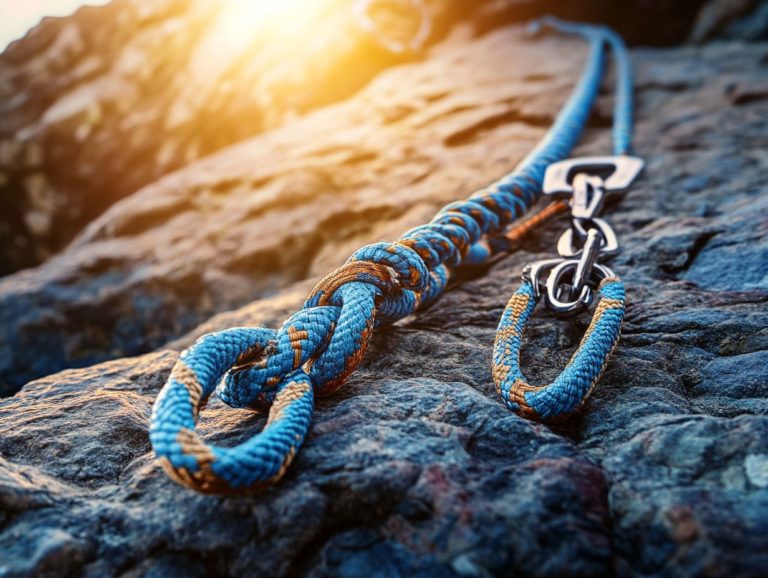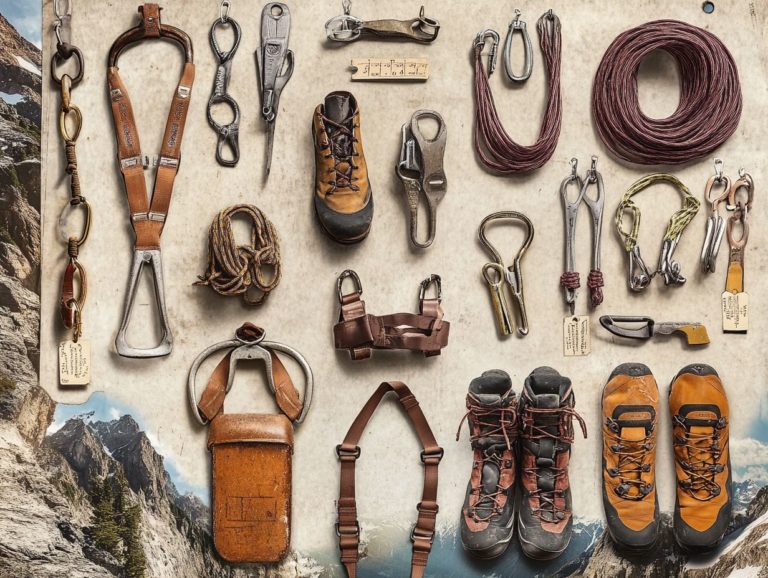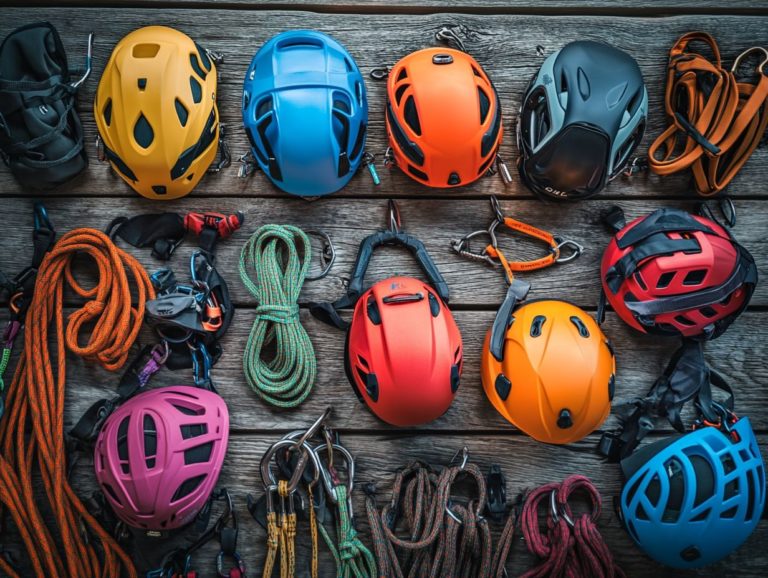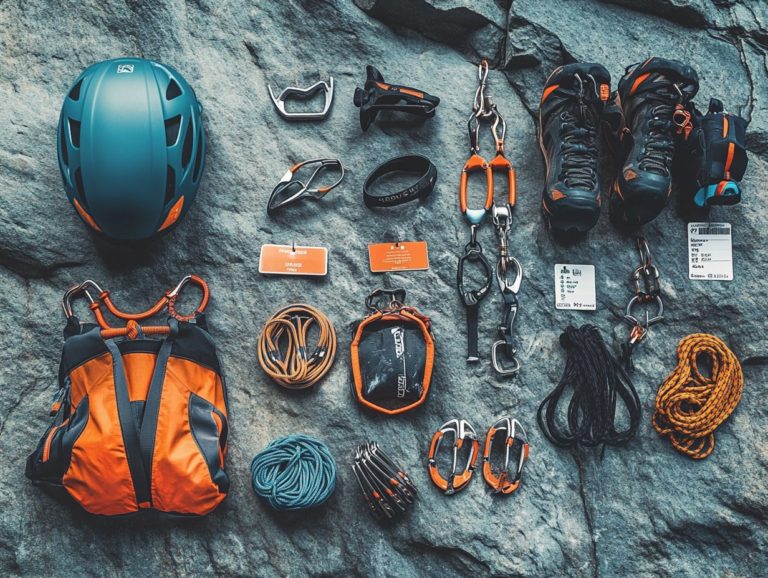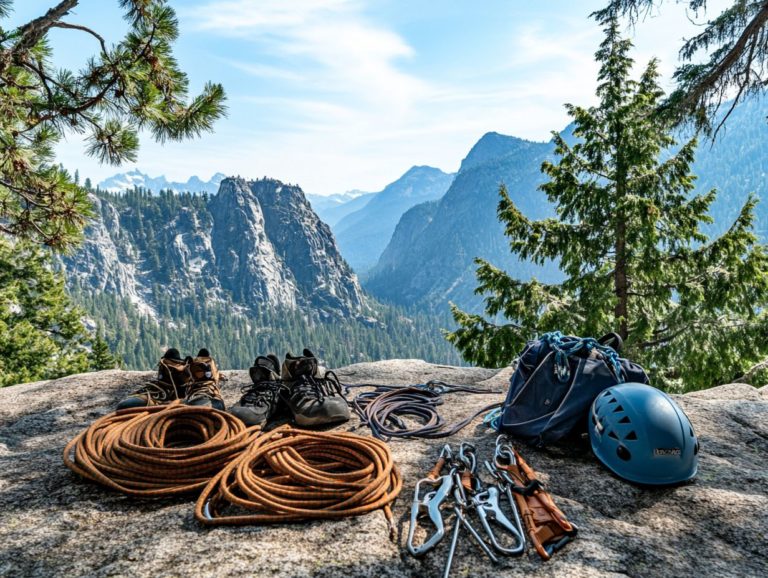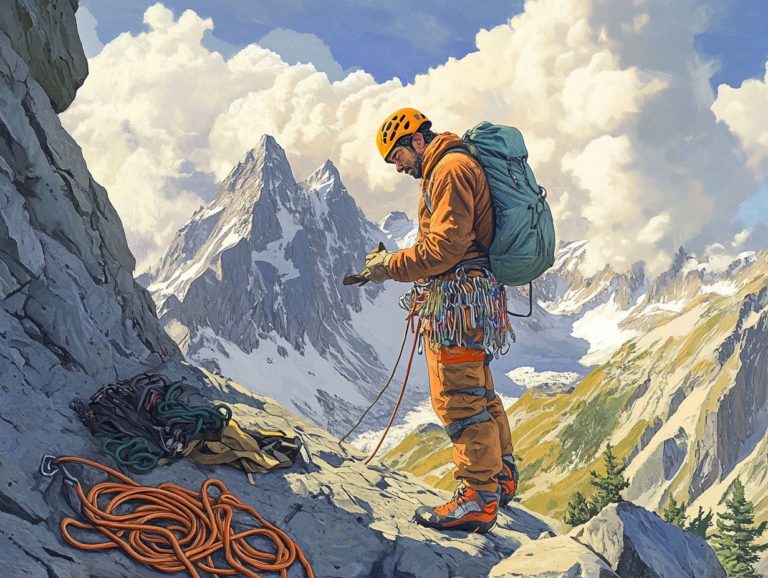The Role of Gear in Climbing Safety
Climbing can be an exhilarating adventure, yet it carries inherent risks that make proper gear absolutely essential. This article delves into the critical role that climbing equipment plays in ensuring your safety while enhancing your overall experience.
You ll discover everything from essential gear types to tips for selecting the right climbing equipment and maintaining it in top shape. We will highlight common mistakes climbers make and emphasize the importance of training and preparation.
Whether you re a beginner or a seasoned climber, grasping the nuances of your gear is crucial for climbing safely and effectively.
Contents
- Key Takeaways:
- The Importance of Gear in Climbing
- Types of Climbing Gear
- Choosing the Right Gear
- Proper Use and Maintenance of Gear
- Common Mistakes to Avoid
- Training and Preparation for Climbing
- Frequently Asked Questions
- What is the role of gear in climbing safety?
- What types of gear are commonly used in climbing?
- How does gear help prevent accidents in climbing?
- Is it important to regularly inspect and maintain climbing gear?
- What should climbers consider when selecting gear for a climb?
- Can using gear guarantee complete safety while climbing?
- Conclusion
Key Takeaways:
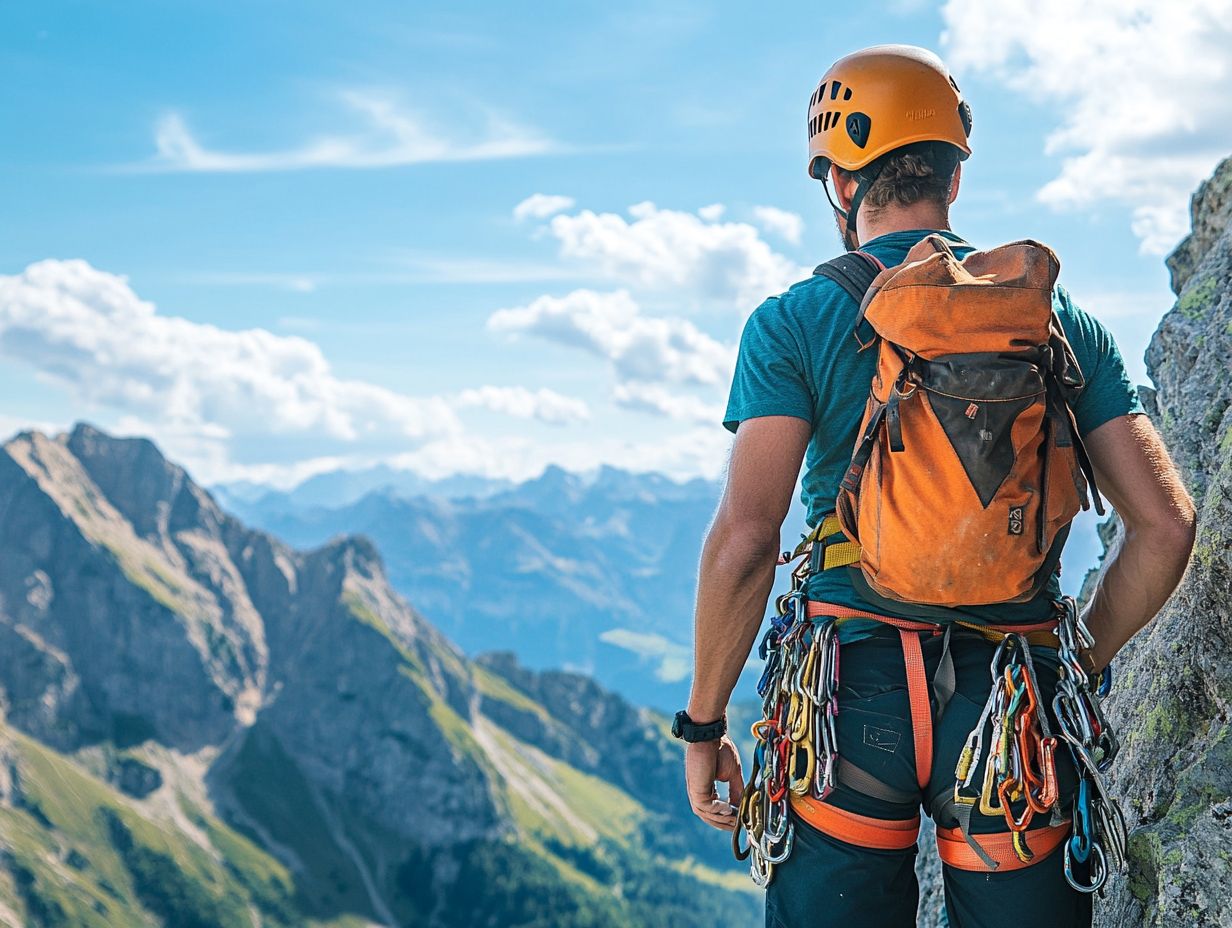
- Proper gear is essential for safe climbing, providing protection against potential risks and increasing overall confidence on the climb.
- When selecting climbing gear, consider fit, durability, and compatibility with your climbing style. Proper use and maintenance of gear is also crucial for safety.
- Avoid common mistakes in climbing, such as using old or damaged gear, not checking gear before use, and neglecting physical training. Investing in quality gear and proper training greatly improves climbing safety.
The Importance of Gear in Climbing
The right gear is vital for safety and performance. It makes climbing enjoyable and protects you on the rock face. From climbing shoes that maximize grip to harnesses and ropes that safeguard against falls, every piece of gear is important to the sport.
By understanding the evolution of climbing equipment and its influence on safety, both novice and seasoned climbers can make informed choices about the right gear for different environments and challenges. This knowledge makes climbing safer and way more fun!
Why Proper Gear is Essential for Safety
Proper gear is essential for your climbing safety, significantly reducing the risks associated with climbing activities, especially when you’re navigating challenging terrains and heights.
The variety of climbing safety gear available today plays a crucial role in safeguarding you during your adventures. Climbing harnesses come in different styles tailored to various climbing disciplines, ensuring you enjoy both comfort and security as you tackle those vertical ascents. To learn more about the different types of climbing gear, check out what are the different types of climbing gear? Ropes, the lifelines connecting you to safety, have evolved dramatically from natural fibers to sophisticated nylon blends that meet stringent safety standards.
Devices like carabiners and belay devices are equally vital, with many earning certifications from organizations like UIAA (International Climbing and Mountaineering Federation), which ensures all climbing gear meets strict safety standards. Reflecting on a memorable climb, the importance of a properly rated climbing rope became strikingly clear when a fellow climber experienced a fall; the gear held strong, reinforcing the trust you place in advancements made within the climbing safety community.
Over the years, climbing safety has transformed tremendously, with historical milestones marking the shift from rudimentary equipment to today’s high-tech, reliable gear. Every climb carries valuable lessons, underscoring the importance of understanding the different types of climbing gear that not only support your adventurous spirit but also protect it.
Types of Climbing Gear
Understanding the various types of climbing gear is essential for your safety and performance, as each piece serves a specific purpose in your climbing journey. Key items include:
- Climbing ropes that ensure your safety during ascents.
- Climbing shoes designed to enhance your grip and precision.
- Harnesses that secure you when suspended.
You ll also find carabiners and quickdraws critical for establishing safe connections between you and your climbing protection. Accessories like climbing tape and chalk are invaluable for improving your grip and minimizing friction.
Familiarity with these tools gives you the power to make informed climbing equipment choices, optimizing your performance across diverse climbing environments.
Overview of Essential Gear for Climbing
Essential climbing gear includes the tools you need for a safe and enjoyable experience. The primary components are climbing ropes, crucial for protection during ascents, and climbing harnesses, which secure you on vertical terrains.
Climbing shoes enhance grip and precision, while climbing packs transport your essential equipment efficiently.
Accessories like climbing tape and chalk improve grip and prevent injury, making them vital for your climbing toolkit.
Understanding each item can significantly influence your performance and safety. For example, advancements in climbing rope technology have led to lighter, stronger materials, such as Kernmantel nylon ropes strong yet lightweight ropes that reduce bulk without compromising integrity. These cater to both sport climbers seeking efficiency and mountaineers prioritizing durability in harsh environments.
Harness designs now offer enhanced comfort and adjustability, accommodating various climbing styles, from bouldering to multi-pitch routes. Innovations in climbing shoe construction, such as synthetic materials and advanced closure systems, provide both flexibility and support.
Specialized chalk formulas minimize dust and enhance moisture-wicking, allowing you to maintain grip longer. Each type of gear is linked to climbing dynamics, so selecting the right equipment can greatly influence your success on the rock face.
Choosing the Right Gear
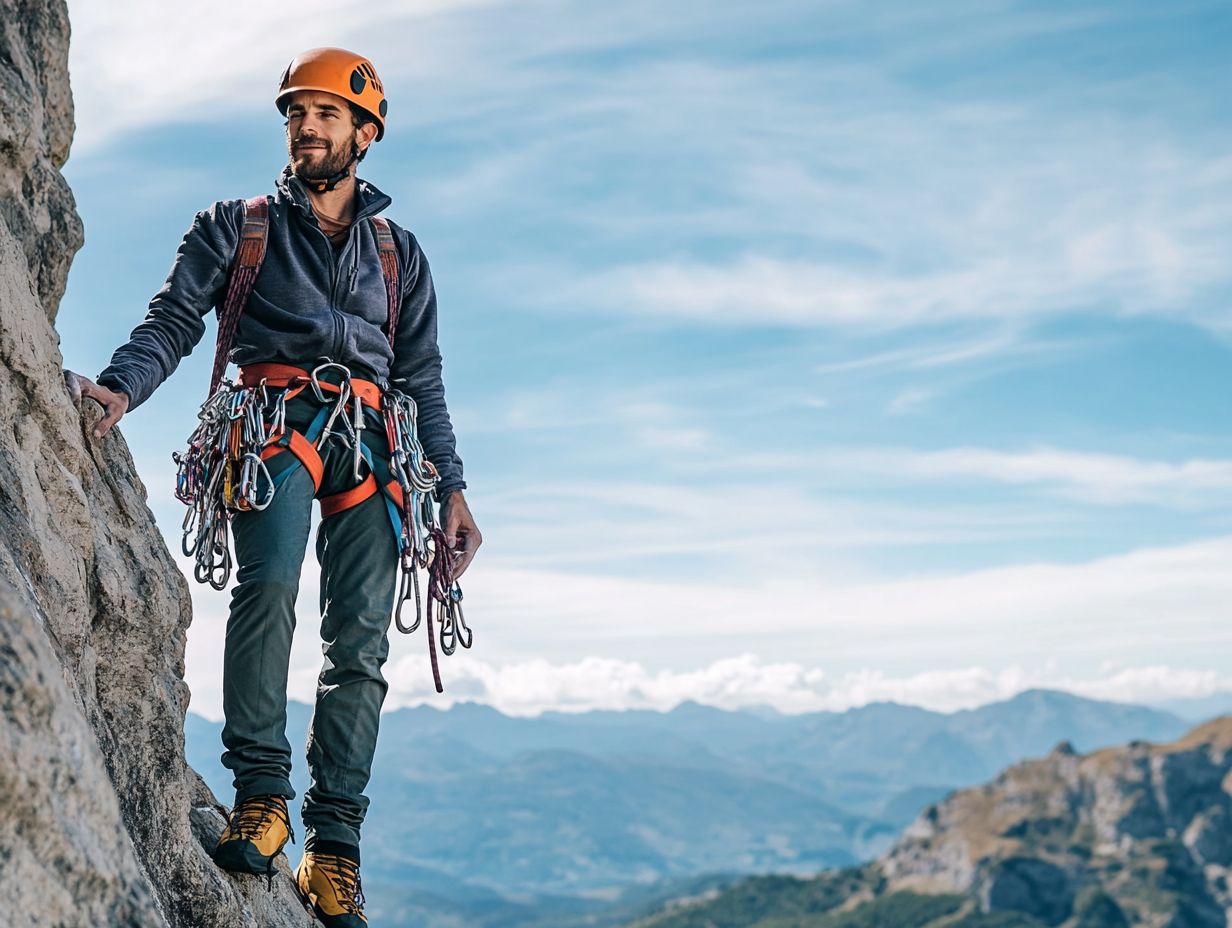
Selecting the right gear for climbing is a pivotal choice that impacts your performance and safety. Different climbing styles and environments require specific equipment, making it essential to weigh your options carefully.
Consider your skill level and the kind of climbing you plan to pursue be it sport climbing, trad climbing, or bouldering. Each environment presents unique challenges, whether you face the limestone cliffs of Eldorado Springs Canyon, Colorado or the granite faces of Devil s Lake in Wisconsin.
Choosing the right gear and understanding climbing techniques empower you to tackle your routes with confidence and safety.
Factors to Consider when Selecting Gear
When selecting climbing gear, several factors related to climbing practices can significantly impact your performance and safety. Your specific climbing style and the environments you ll encounter will guide your choices.
Top-quality harnesses, ropes, and carabiners are crucial for your safety as they directly affect durability and reliability in critical situations. You need gear that can handle the challenges you face.
The weight of the equipment influences your agility and stamina, especially during long ascents or when navigating difficult terrain.
Compatibility with other gear, like specialized helmets or climbing shoes, is essential for an efficient and safe climbing experience.
Understanding your personal preferences such as comfort levels and climbing objectives enhances your selection process and allows you to feel confident and secure as you embark on your adventures.
Proper Use and Maintenance of Gear
Proper use and maintenance of climbing gear are essential for ensuring your safety and achieving optimal performance during climbs. Neglecting your gear can seriously compromise both safety and your climbing experience.
Regularly inspect and maintain vital climbing equipment like ropes, harnesses, and carabiners to spot wear and tear that could lead to failure at critical moments.
Familiarizing yourself with proper gear usage, including climbing techniques and safety protocols, enhances your performance and cultivates a culture of safety among your climbing partners.
Tips for Safe and Effective Gear Usage
To ensure safe and effective gear usage, familiarize yourself with the proper techniques, practices, and safety measures associated with each piece of equipment.
A thorough understanding of climbing techniques elevates your performance and cultivates a sense of teamwork during climbs. When using a harness, making proper adjustments significantly impacts your stability and security. Expert climbers recommend double-checking the buckles and ensuring a snug fit on the climbing harness, as well as understanding what gear is required for rock climbing, as simple practices that can prevent accidents.
Integrating techniques like the ‘clove hitch’ and knowing when to use a belay device are essential for managing rope tension effectively. By observing seasoned climbers, you can appreciate the seamless coordination that comes from mastering gear interactions, enhancing both safety and enjoyment.
Common Mistakes to Avoid
Avoiding common mistakes in climbing can greatly enhance your performance and safety.
Many challenges arise from improper gear usage or a misunderstanding of techniques. Prioritizing knowledge and skill elevates your climbing experience, especially when you have access to the top climbing gear for rock climbers.
Potential Risks and How to Avoid Them
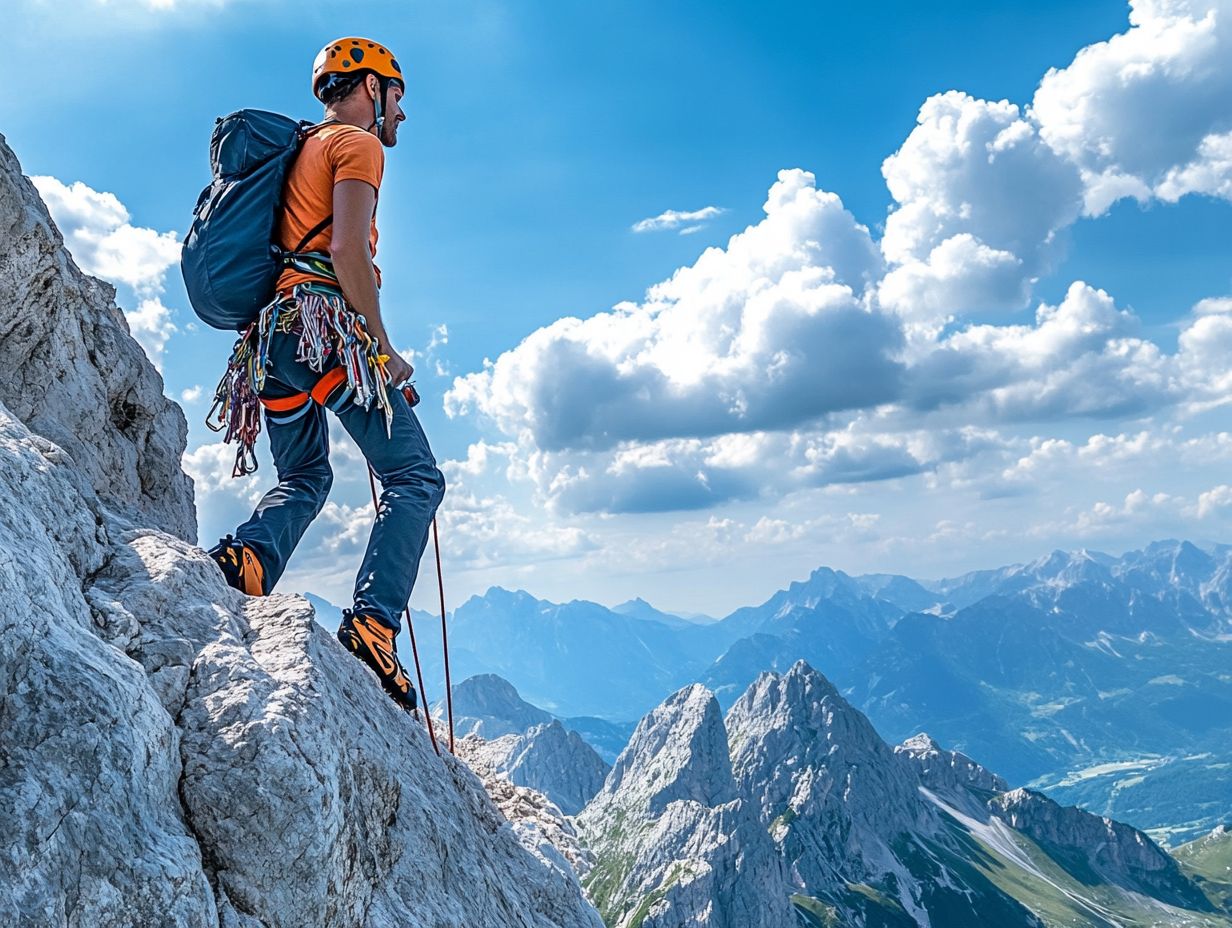
Are you ready to tackle the risks of climbing? You can significantly mitigate them by mastering the right techniques and safety protocols, along with effectively using your gear.
You may encounter challenges like gear failure or accidents from improper techniques. Both can lead to serious injuries. Don t wait make regular gear inspections a habit! Routinely check your ropes, harnesses, and carabiners for any signs of wear.
Understanding the correct body mechanics, such as how to hold onto rocks and foot placements, can greatly reduce your chances of falling. Engage in thorough pre-climb safety checks, practice falls in a controlled environment, and seek guidance from experienced climbers to enhance your skills.
This proactive approach ensures your climbing adventures are not only safer but also far more enjoyable.
Training and Preparation for Climbing
Training and preparation are critical for elevating your performance and ensuring a safe climbing experience. As a climber, cultivate strength and endurance tailored to the unique challenges of your chosen styles.
Building Strength and Endurance for Safe Climbing
Building strength and endurance is essential for you to conquer challenging routes while ensuring safety. Boosting your physical fitness directly enhances your climbing performance.
To reach your goals, engage in a carefully designed blend of exercises that target key muscle groups and improve cardiovascular fitness. Bouldering sessions enhance explosive strength, while interval training elevates your aerobic capacity. Look at climbers like Adam Ondra; he incorporates weighted pull-ups and deadlifts into his routine, highlighting the importance of core stability and grip strength.
Don t overlook tools like a hangboard to develop your finger strength, crucial for tackling overhanging routes. By integrating these training techniques, you can dramatically boost your endurance and strength, paving the way for greater success on the wall.
Frequently Asked Questions
What is the role of gear in climbing safety?
Gear plays a vital role in ensuring the safety of climbers by providing protection and support as they navigate challenging terrain.
What types of gear are commonly used in climbing?
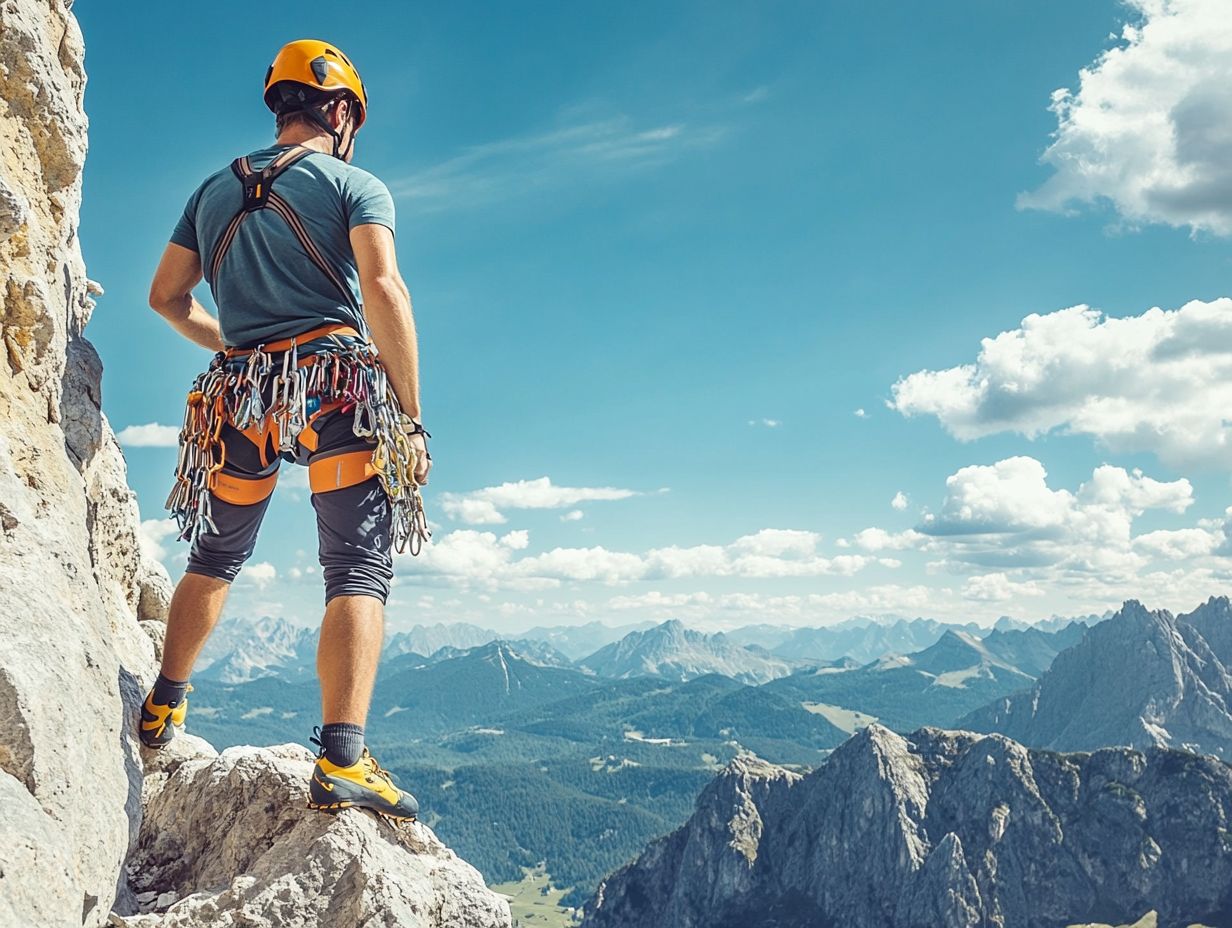
Climbing gear includes ropes, harnesses, carabiners, and helmets. It also features safety tools like nuts, cams, and hexes.
How does gear help prevent accidents in climbing?
Gear acts as a safety net during falls. It also provides stability and balance while climbing.
Is it important to regularly inspect and maintain climbing gear?
Regularly inspecting and maintaining climbing gear is crucial. Over time, gear can wear down and become less effective.
What should climbers consider when selecting gear for a climb?
Climbers should think about the type and difficulty of their climb. They must also consider their skill level and choose gear that s in good condition.
Can using gear guarantee complete safety while climbing?
Gear doesn t guarantee complete safety, but it’s your first line of defense! Proper training and knowledge are essential for a safe climbing experience.
Conclusion
In summary, the right climbing gear is essential for safety. Always choose quality equipment, regularly inspect it, and prioritize your training to ensure a safe and enjoyable climbing adventure.

